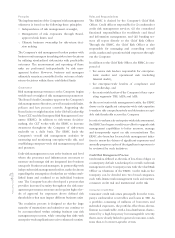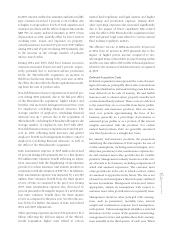American Express 2004 Annual Report Download - page 52
Download and view the complete annual report
Please find page 52 of the 2004 American Express annual report below. You can navigate through the pages in the report by either clicking on the pages listed below, or by using the keyword search tool below to find specific information within the annual report.
partially offset by lower transaction fees related to
growth in on-line transaction activity. The volume and
type of travel sales are important as the Company earns
revenue based on both the number of transactions as
well as the sales mix of travel purchased. Travel commis-
sions and fees rose 7 percent to $1.5 billion in 2003 as a
result of higher revenue earned per dollar of sales
coupled with a 3 percent increase in travel sales, prima-
rily due to the acquisition of Rosenbluth in the fourth
quarter of 2003.
Other commissions and fees of $2.4 billion increased 16
percent on greater volume-related foreign exchange
conversion fees and higher card-related assessments
and network partner-related fees. Other commissions
and fees increased 4 percent in 2003 to $2.1 billion due
to higher card-related fees and assessments.
Expenses
During 2004, TRS’ expenses were up 11 percent to $18.4
billion reflecting greater marketing, promotion, rewards
and cardmember services expenses, higher human
resources expenses and increased total other operating
expenses, partially offset by reduced provisions for
losses and lower interest costs. Expenses in 2004
included $64 million in aggregate charges recorded in
the fourth quarter principally relating to the restructur-
ing of business travel operations. These charges
included $46 million of employee severance obligations
included in human resources expenses and $18 million
of other exit costs primarily relating to the termination
of certain real estate property leases. Also included in
2004 expenses was a $117 million net gain on the fourth
quarter sale of the equipment leasing product line in the
small business financing unit. Expenses in 2003 of $16.6
billion were 6 percent higher than 2002 primarily due
to greater marketing, promotion, rewards and card-
member services, human resources and total other
operating expenses, partially offset by reduced provi-
sions for losses and interest costs.
Marketing, promotion, rewards and cardmember ser-
vices expenses increased 32 percent in 2004 to $4.9 bil-
lion reflecting both greater rewards costs and higher
marketing and promotion expenses. The growth in
rewards costs is attributable to a higher redemption
rate, strong volume growth and the continued increase
in cardmember loyalty program participation. The
increase in marketing and promotion expenses is pri-
marily due to the Company’s new global brand adver-
tising campaign and the continued focus on business-
building initiatives. Marketing, promotion, rewards and
cardmember services expenses increased 27 percent in
2003 to $3.7 billion on the continuation of brand and
product advertising, an increase in selected card acqui-
sition activities and higher cardmember rewards and
services expenses reflecting higher volumes and a
higher redemption rate.
Total provisions for losses decreased 6 percent in 2004
primarily as a result of a reduction in cardmember lend-
ing provision offset by a net increase in other provi-
sions. Provision for losses on the worldwide lending
portfolio decreased 9 percent to $2.1 billion in 2004,
despite growth in loans outstanding and increased
reserve coverage levels of past due accounts, due to
well-controlled credit practices. The worldwide lending
provision decreased 7 percent in 2003 to $2.3 billion.
The net write-off rate for the worldwide lending port-
folio was 4.3% in 2004 as compared to 5.2% and 5.9%
in 2003 and 2002, respectively.
Other provisions increased in 2004 primarily reflecting
a reconciliation of securitization-related cardmember
loans, which resulted in a charge of $115 million
(net of $32 million of reserves previously recorded),
for balances accumulated over the prior five-year
period as a result of a computational error. The amount
of the error was immaterial to any of the periods in
which it occurred.
Separately, other provisions were favorably impacted
by a reduction in merchant-related reserves of approxi-
mately $60 million reflecting changes made to mitigate
loss exposure and ongoing favorable credit experience
with merchants.
In 2003, total provisions decreased 9 percent primarily
due to the decrease in the lending provision noted
above and an 11 percent reduction in the provision for
losses on charge card products primarily due to strong
credit quality reflected in an improved past due percent-
age and loss ratio.
Charge card interest expense declined 9 percent and 20
percent during 2004 and 2003, respectively, due to a
lower effective cost of funds, partially offset by a higher
average receivable balance. During the fourth quarter of
2004, the Company experienced an increase in the
effective cost of funds.
Human resources expense increased 15 percent to $4.4
billion in 2004 primarily due to increased costs related
to merit increases, greater management incentives and
higher employee benefit costs as well as the impact of
the late 2003 acquisition of Rosenbluth and $46 million
of severance-related restructuring costs noted earlier.
Human resources expenses increased 9 percent in 2003
AXP
AR.04
50
Financial Review
























